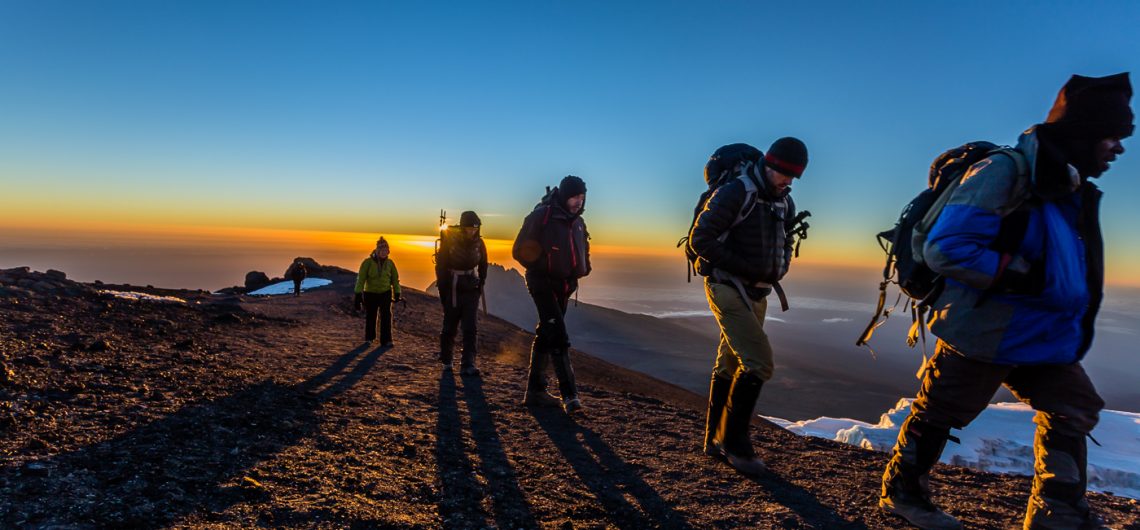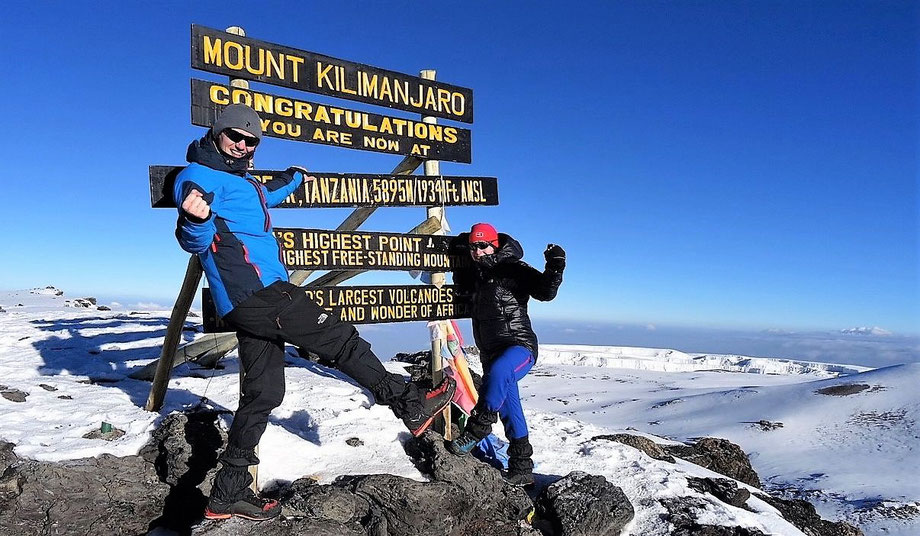The summit night on Mount Kilimanjaro will be a challenge no matter what! All of our 8-day Kilimanjaro treks begin on the summit night at Kosovo Camp, 4,900 meters/16,076 ft. Trips to Uhuru Peak usually begin in Barafu Camp, which is located at 4,650 meters/15,256 ft. Kosovo Camp provides the finest opportunity for our clients to succeed. On the majority of our 8-day Lemosho Route tours, we are getting high 85-%100% summit success rate.
All roads lead to the Summit
Barafu Camp is located at 4,650 meters (15,256 feet) while Kosovo Camp is located at 4,900 meters (16,076). Your Kilimanjaro trek will be divided into two parts: night and day.
You’ll probably depart about midnight if you’re leaving from Barafu Camp, and around 1 am if you’re leaving from Kosovo Camp. Reaching the summit of Kilimanjaro at 5,895 meters/19,341 feet is a long, arduous, and mental effort no matter where you start.
Related: Why do people climb Kilimanjaro at night?
How we summit at night to Uhuru Peak
We have established the ideal method for summit night to enhance safety and success after 17 years of climbing on Kilimanjaro. We will take off from Kosovo’s upper camp if the weather permits and the winds are light. Our crews are able to accomplish this because we took sufficient time to acclimate lower on the Shira Plateau.
Going all the way to Kosovo Camp for the night might be perilous if you’re only on a 5-7 day vacation. The reason for this is that without enough acclimatization, your body would be unable to deal with the altitude.
Our goal is to get to the Barafu camp at 11:00 a.m. or the Kosovo camp at 12 p.m. Indeed, this will allow our bodies to acclimate further and, most importantly, rest and sleep. We will be positioned away from the noise of the main camp by staying at the upper camp. Examine your elevation increases.
It will be time to wake up at 11 p.m. and begin getting dressed and getting your things ready.
It is critical to begin drinking water cautiously. The objective is to consume at least 2 liters of water before leaving on summit night. Breakfast will be provided in the dining tent at 12:15 a.m., and you may fill your Nalgene bottles with boiling water for the night. For their summit attempt, some individuals choose to bring two Nalgene bottles (2 liters of water). How much you carry is a personal decision. Make sure you stay hydrated during your journey, even before you begin the Kilimanjaro climb. Our Head Guide is the best on Kilimanjaro, so you’ll be in good hands.
Read also: What to expect on summit night when climbing Kilimanjaro
Begin your climb to Kilimanjaro’s summit.
We’ll start trekking towards the top around 1 a.m. On the way to the peak, we’ll try to climb 200 meters (656 feet) each hour. Our objective for summit night is to stick to a rigid regimen while ascending. We’ll walk about an hour, then stop to drink water, eat snacks, and use the restroom just off the route. Depending on the weather, each halt will last 5 to 7 minutes. We’ll do this for the next 5 hours as we steadily climb over 5,500 meters/18,000 feet. We may need to stop every 30 minutes as we approach this level since the shortage of oxygen gets increasingly difficult.
As the sun sets on the horizon, we’ll begin to make our way toward Stella Point.
Up and down the steep terrain
The last stretch to Stella Point is one of the most difficult of the night. As you concentrate on deep breathing, the pace will be gradual and steady. Because it will most likely be quite chilly when we arrive at Stella Point, we will take a 5-minute break and have some hot tea. We’ll then continue for another 50 minutes to the genuine top. The terrain is now a little simpler to reach Stella Point than it was in the previous hours. Because the shortage of air is difficult, you must concentrate on deep breathing all the way to the peak.
On your summit attempt, the most crucial thing you should be thinking about is getting oxygen into your body. You will reach the peak of Kilimanjaro after 6/7 hours of going upwards!
Standing atop the roof of Africa! Uhuru Peak, Summit
Enjoy your success of reaching Mount Kilimanjaro’s peak!! You’ve been dreaming of this moment for months, if not years. Enjoy the moment because you will remember it for the rest of your life. Remember that you are just halfway thereafter the difficulty and challenge of reaching the pinnacle. The descent is steep and requires a lot of concentration due to the difficult terrain.
 The Descent Is Steep
The Descent Is Steep
Then we’ll start moving back to high camp as a team, which should take about 3 hours. It is critical to descend as rapidly as possible below 5,500 meters/18,000 feet. You will have some time to relax, rehydrate, have a complete lunch, pack your luggage, and slowly make your way down the path depending on when we arrive at high camp. At 3,100 meters/10,171 feet, we’ll descend all the way to Mweka Camp. The descent to the camp is 2,795 meters/ 9,170 feet from the top! Reaching this distance will most likely be one of the most difficult days of your life!
Choose 8 days to hike the Lemosho route.
Our 8-day hikes are strongly recommended if you want to give yourself the greatest and safest opportunity of trekking to 5,895 meters/19,341 feet. Watch the video above to witness some raw footage from Kilimanjaro’s summit night. REVIEWS from our travels may be found here.
Safety is jeopardized due to a lack of physical preparation.
Our very able mountain guides have climbed the mountain numerous times. From their mountain experiences, the final two hours to the Crater Rim are when they reportedly see people suffer the most. People seldom train by going on lengthy 5+ weekly hikes to increase their endurance.
Because of the cold, you must keep moving, however at a very sluggish rate. As a result, you’ll be able to take your time, and the squad will be able to make many brief pauses at this point. It’s now a mental game in which you must trust yourself and dig deep. The majority of the difficult labor has been completed. You can go to the summit if you dig deep and breathe deeply. Check out our training tips.
Sleeping low helps with the recovery process.
After you’ve savored the top of Kilimanjaro, you’ll need to descend from such a high height. As previously said, returning to the high camp will take around 3 hours. After the short break at high camp, you’ll pack up and hike another 3/4 hour to Mweka Camp, which is located at 3,100 meters/10,170 feet. You’ll be back in the rainforest soon, and you’ll be able to celebrate your summit victory. This might be a 12- to 14-hour day in total, and it can be exhausting! As a result, you’ll need the finest acclimatization possible in the weeks leading up to this difficult summit night climb on Kilimanjaro. For more information about our climbs, CLICK HERE.
![]()


 The Descent Is Steep
The Descent Is Steep
Comments